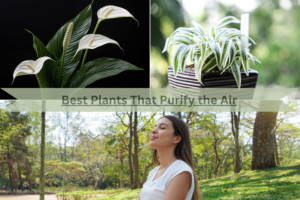Do you want to learn about the best plants that purify the air in your home? These are the most highly studied plants and by far the most popular among hundreds of plants known to purify the air in your home. You can take these tips and apply them to any space including work office buildings, daycare centers and schools.
Having clean air in your home is extremely important for your health and wellness. There are so many plants to choose from that the list of options can seem daunting.
The plants on this list are the most popular plants chosen by millions of plant lovers and have been deemed as the best plants that purify the air for decades. Scientists who have studied plants that purify the air have agreed that these specific plants are the most effective at purifying the air.
After reading this post you will have a good idea of which plants you might want to choose from and where you might place them.
Best Plants That Purify the Air
-
Snake plants
Snake plants are also known as Sansevieria plant or Dracaena trifasciata. This is probably one of the most commonly seen plants in office settings and homes. They are fairly inexpensive depending on which variety you purchase. They come in a variety of sizes and colors ranging from green to yellow (e.g., Lauren snake plant or Yellowstone) and even silvery colored ones (e.g., moonshine or moon glow). These can be placed in the living room, hallways, bathrooms or office cubicles. Be advised these are toxic to cats and dogs. However, I will say we have cats and keep snake plants in the home because they don’t bother the plants but if your pet likes to attack your plants it’s better to be on the safe side and opt for safer plants that get the job done. (click here to learn more about the snake plant)
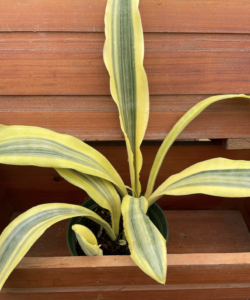
-
English Ivy
English Ivy (Hedera helix) is a vining plant that is usually dark green but some varieties are lighter and have variegation on them (i.e., white striping or white borders on the leaf body). They are low maintenance plants that usually grow in shade or partially shaded areas and they can thrive in low light conditions (they can also grow in full sun if you acclimate them slowly). If you plan to keep them in a room that is dim you can bring it out somewhere brighter from time to time to let it get a little boost for a day or so before returning it back to the dimmer area. They can also be hung from the ceiling with a hook or mounted on the wall with hooks to fasten the growing vines. Water thoroughly when the soil feels 80% dry. English ivy is toxic to cats and dogs.
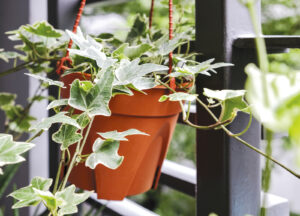
-
Spider plant
Spider plants (Chlorophytum comosum) are very common and fairly inexpensive. You can usually find them at any garden center and they are very easy to grow. Spider plants grow little babies that hang from the mother plant which can be cut off and planted into a new pot. They usually are plain green or green with white stripes and they grow up and out similar to the shape of a fountain. This plant is perfect for hanging baskets from the ceiling or mounted on a wall. Bright, indirect light is best for these beauties, water when the soil is dry. Spider plants are safe for cats and dogs but be sure to check with your veterinarian before purchasing any plants for your home.
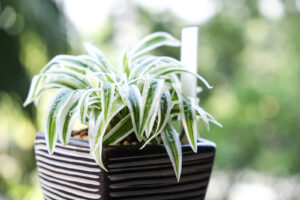
-
Aloe vera
Aloe vera is not as common to keep indoors; most people grow aloe outside but they are highly effective at purifying the air which makes them an excellent choice for indoor use. They have medicinal benefits as well so this plant is nice to have around for multiple uses. Be sure that you have a bright area in which to place them. They are low maintenance and can survive periods of drought. They may not do well if you keep it very cold inside your home. Ideally, they should be between 70-110 degrees but they can do well in colder temps for short periods. Aloe is toxic to both cats and dogs.

-
Peace lily
Peace lilies are very common for indoor use, they are inexpensive and low maintenance which makes them a good choice for beginners. Do not place them in direct sunlight as the leaves will become scorched and wither away. They do best in bright, indirect light. Peace lilies are sometimes called spath which is a shortened nickname of its scientific moniker ‘Spathiphyllum wallisii’. This plant is often given as gifts on Mother’s Day or Easter. Unfortunately, these lovely plants are toxic to cats and dogs so please beware before purchasing.
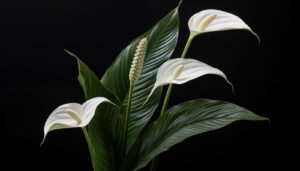
-
Bamboo palm
Bamboo palm (Chamaedorea seifrizii) is a great option for people who want a large plant. These grow up to six feet in height and about three feet in width. Although they are called bamboo palm, they are unrelated to actual bamboo plants. They thrive in bright, indirect light and will scorch if you put them in direct sun. They are extremely efficient at purifying the air and producing fresh oxygen. This is one of the few varieties of plants that are safe for cats and dogs, there are others but they may not be readily available or easy to purchase. Be sure to ask your veterinarian before placing any plants in and around your home they may have other plant options that they can suggest for you.

-
Pothos
Pothos (Epipremnum aureum) are known for their beautiful vining structure and can be grown in many different ways. Some people like to grow them in water with leca pebbles while others may grow them in a vase with straight water. The healthiest medium would be soil but with the different options available you can experiment a little with what you prefer. Pothos are also very easy to come by and inexpensive like most of the plants on this list. There are some beautiful varieties that can brighten up your home while also purifying the air inside. The most popular pothos sold in stores is commonly referred to as ‘marble queen’ but my personal favorite is the stunning pothos ‘neon’ which has bright yellow leaves with a hint of green (shown in picture below). Whichever you choose, they all work well at purifying the air around them. Pothos are toxic to cats and dogs.

